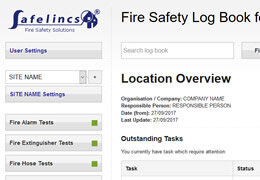-
Contact
Sales & Customer Service
0800 612 6537 support@safelincs.co.uk Live ChatDelivery Enquiries
0800 077 6149 - Resources
Fire & Safety Solutions
CALL OUR TEAM NOW 0800 612 6537
Lines open today 8am - 6pm
Free Delivery
on 100s of Products
Secure Payments
with our fast checkout
Live Customer Chat
Available Now
30 Day Accounts
for Public Sector
5 Star Customer Feedback
Fire Safety on Construction Sites
Every year there are many fires on construction sites and in buildings undergoing refurbishment; people are injured or killed, property is destroyed, including irreplaceable heritage buildings and the industry suffers disruption and unexpected costs from which many never recover. This article demonstrates how the interested parties in any construction or demolition project can reduce the number of hazards present on a building site. By controlling the ignition and combustible hazards on site, the fire risk can be reduced.
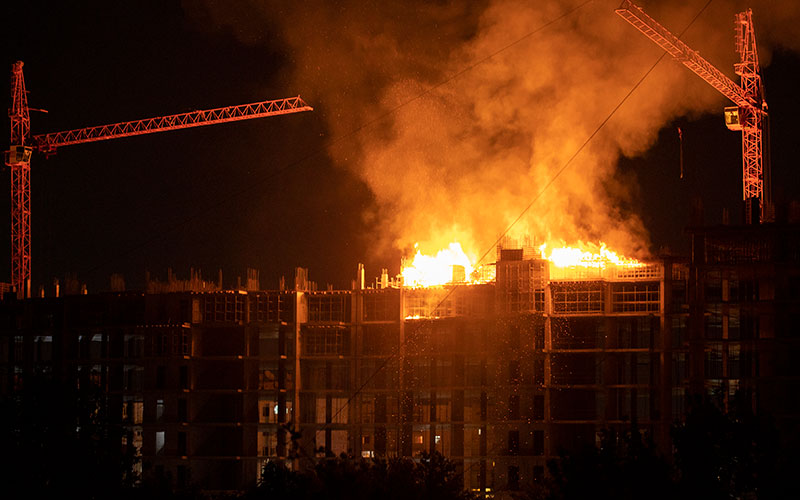
Legal Requirements for Constuction Sites
With respect to building sites the Construction (Design and Management) Regulations 2015 (CDM) define duties (see table 1) in relation to fire safety and identify factors that should be taken into account when making fire safety arrangements; the Regulatory Reform (Fire Safety) Order 2005 (FSO) (England and Wales) sets out who is responsible for enforcement. Although the legislation has changed in recent years, in practice the requirements in relation to fire risk assessment and controls and the range of practical precautions have not changed.
CDM Regulation 29 requires that "Suitable and sufficient steps must be taken to prevent, so far as is reasonably practicable, the risk of injury to a person during the carrying out of construction work arising from - (a) fire or explosion; (b) flooding; or (c) any substance liable to cause asphyxiation." CDM Regulation 30 requires that "Where necessary in the interests of the health or safety of a person on a construction site, suitable and sufficient arrangements for dealing with any foreseeable emergency must be made and, where necessary, implemented, and those arrangements must include procedures for any necessary evacuation of the site or any part of it."
The principal contractor should ensure that fire risk assessments are carried out in accordance with fire safety legislation applying to that country. The modern risk based approach to fire safety has seen the introduction of the Fire Risk Assessment (FRA) into fire safety compliance by the Regulatory Reform (Fire Safety) Order 2005 (FSO) (England and Wales), the Fire Safety (Scotland) Act (Scotland) and The Fire Safety Regulations (Northern Ireland). The FSO deals with fire safety in all buildings in England and Wales with the exception of single private dwellings; legislation in other countries may differ and should be checked. The FSO in respect of construction sites is enforced by the Health and Safety Executive.
Guidance on fire safety for construction sites is available in HSG168 Fire Safety in Construction - Guidance for Clients, Designers and Those Managing and Carrying Out Construction Work Involving Significant Fire Risks and guidance on the legal requirements for CDM 2015 can be found in L153 Managing Health and Safety in Construction.
Fire Hazards in Construction
The two areas where the site management can exercise control are with respect to ignition and fuel sources. If the hazard can be eliminated or controlled then the probability of fire starting and growing to a point where life is at risk is significantly reduced.
Ignition Risks
The main ignition risks under management control are listed.
- Electrical faults - fixed electrical systems and portable equipment. Sites will have a combination of fixed electrical wiring from mains sources and electricity generated from fixed and/or mobile power generators. All electrical installations must be tested, inspected and commissioned before becoming available for use and at suitable intervals. Portable Appliance Testing (PAT) should be carried out in accordance with the HSE guidance note HSG107 which advocates a risk-based testing policy.
- Hot working - hot works are defined as all "processes involving the generation of heat by a naked flame, electrical arc, sparks, and the use of bitumen boilers or grinding". Cutting operations may use open flame gas cutting equipment or disc cutting; acetylene should not be permitted on site unless absolutely necessary.
- Smoking - smoking is usually prohibited on site or designated smoking areas are provided away from the main work site and the site offices.
- Temporary lighting and lamps - where necessary the illumination of work areas is from temporary lighting installed or from specific task lighting. The hazards from such lighting come from placing light units too close to combustible items or not allowing the lamps to cool or from broken lamp units where hot surfaces are exposed. Lighting units should be secured in position away from combustible material to prevent them being dislodged. Halogen and halide lights should not be used due to their high operating temperatures. Lamp holders should be provided that ensures bulbs of different operating voltages cannot be interchanged and those not fitted with a bulb should be capped off. Light units should be inspected periodically and broken units should be removed immediately.
- Portable heaters - portable heaters should only be permitted where necessary and then portable heaters should be regarded in the same category as 'hot work' and an assessment should be made of the suitability of the heater and its location; the most hazardous types of portable heaters should be avoided.
- Arson - access to a site should be strictly controlled and supervised around the clock where necessary; there are many reasons given by an arsonist for starting a fire and the issue for the site management is to reduce the opportunity for an arsonist to strike. Management of waste is important as combustible materials present ready opportunities for arson.
- Lightning - lightning protection systems shall be provided where appropriate and should be tested annually with certificates provided to confirm a satisfactory test.
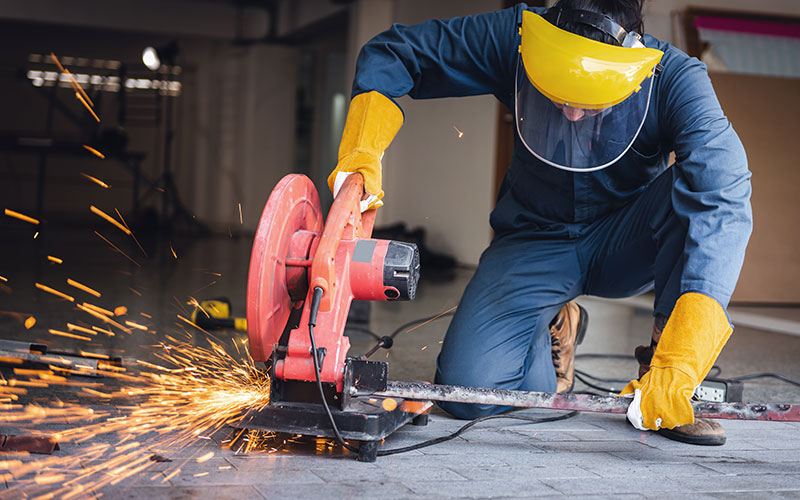
Fuel Hazards
Where combustible materials are used on site the provision of materials should be limited to those absolutely necessary or when appropriate those specifically designed for high risk sites. There are a variety of flammable materials with the potential to be stored or used on site that include scaffold boards and sheeting, temporary covering materials, waste that has been removed from building materials and bagged waste awaiting disposal.
- Combustible building components - the control of combustible materials is fundamental to site safety and materials should not exceed the quantities required for a day's work; storage of combustible items should be limited and a gap of 6-10m should be left between any fuel packages. Care should be taken not to leave any readily ignitable substances near to fuel packages - for example a stack of wood is difficult to ignite with a small pilot flame but if it is still in flammable packaging or adjacent to a pile of waste the energy required to ignite the wood stack may become available. Fires in multi-storey timber frame buildings during construction have an obvious high fire loading and this has led to some serious fires and rapid collapse of the unprotected frame. Timber frames will burn faster and more completely when the panels are not protected by the usual internal fire resistant plasterboard and external cladding. Many studies and reports have been written for timber frame sites; following this guidance will give basic protection but specific guidance is available from the Structural Timber Association among others.
- Fire retardant scaffold and temporary covering materials - even those combustible materials tested and marked as complying with fire retardant standards should be stored on site in limited amounts and any necessary preparation such as cutting to size should be carried out in a remote location. Materials that must be marked as fire retardant:
- Timber scaffold boards should be marked as 'Firesafe' boards indicating they are treated to comply with BS EN13501-1:2018 - Euroclass B or C. The boards are combustible but have been treated to provide some protection; care should be taken with cut or damaged boards as these may not exhibit similar characteristics where dust and crumbs in particular may burn more freely.
- Temporary coverings should be tested to LPS 1215 and this standard describes performance requirements with regard to flammability that should not add to the fire risk on site.
- Protective coverings for floors, walls etc. should be tested to LPS 1207 which describes performance requirements with regard to ignitibility, smoke emission, toxic gas emission and oxygen index.
- Flammable gases and liquids - fuel may be required for hot cutting and plant and this may be in the form of flammable gases such as LPG or liquid fuel for generators. Management of fuel is the responsibility of the site manager and should include the whole process from procuring the correct fuel, its use and the potentially hazardous operations such as refuelling.
- Waste materials - waste should be minimised wherever possible and disposed of as soon as possible. Packaging and waste materials from the work processes should be disposed of regularly and part of the management function should be to check areas for effective disposal in accordance with a Waste Management Plan for the site. Plastic waste containers should not be permitted and wherever possible metal containers should be used. If oils and grease are used and cleaning rags are stored together there is a possibility of spontaneous ignition with some contaminants; any cleaning rags should be disposed of immediately when used for cleaning oily deposits.
Fire Control Measures in Construction
The principal contractor must draw up a construction phase plan and this should include the fire safety and emergency procedures for the site; see Appendix 3 of L153 for further details of the plan. The plan must include suitable and sufficient arrangements for dealing with any foreseeable emergency including:
- Sufficient number of suitable emergency routes and exits that must be kept clear and free from obstruction and, where necessary, provided with emergency lighting so that it may be used at any time
- Exit routes must be indicated by suitable signs
- Where necessary suitable and sufficient fire-fighting equipment and fire detection and alarm systems must be installed
- Workers must be instructed in the correct use of fire-fighting equipment
Emergency Routes and Fire Exits
The basic principle of means of escape is that a person confronted by a fire can turn their back on it or pass it safely to reach a place of safety; this can be a place of relative safety such as a protected staircase or ultimate safety away from the building. The provision of an alternative means of escape avoids a single direction of travel, or 'dead-end' conditions, where escapees may become trapped by fire or smoke. HSG 168 gives guidance on maximum travel distances as replicated in Table 1 below:
| Fire Hazard - see HSG168 | ||||
|---|---|---|---|---|
| Lower | Normal | Higher | ||
| Enclosed Structures | Alternative | 60m | 45m | 25m |
| Dead-end | 18m | 18m | 12m | |
| Semi-open Structures | Alternative | 200m | 100m | 60m |
| Dead-end | 25m | 18m | 12m | |
Where building sites are close to neighbouring properties issues can arise with blocked exits from the existing building; particularly in urban situations where access is restricted. Sites where there is a high combustible loading such as timber framed buildings, radiated heat and fire spread need to be considered. Exit routes need to be clear and uncomplicated; routes should be appropriately signed and lit. Where stairways are required these may be temporary stairs or part of the ongoing construction in which case they will need to be fire separated as soon as possible from the remainder of the site and lead directly to open air.
Temporary stairs can be fabricated from scaffolding or by using a proprietary system; they should be separated from the building using the external wall and any openings less than 1.8m horizontally away from or 9m below the stair should be protected with 30 minutes fire resistance.
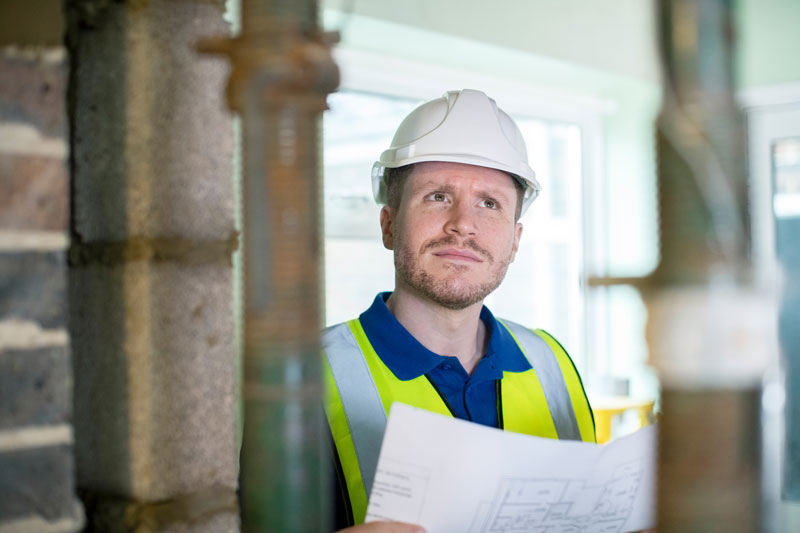
Temporary Fire Doors
Horizontal and vertical fire compartmentation may be required during the construction phase. This is especially true for high rise buildings. Fire compartmentation contains a fire to prevent it from spreading throughout the building. Fire doors are usually part of a passive fire protection system provided by walls, floors, doors and ceilings. This system will protect escape routes and limit damage to the building. Usually an FD30 fire door is sufficient as it withstands fire for at least 30 minutes – long enough for occupants to escape and the fire to be extinguished. In some cases, however, it may be necessary to install a higher rated fire door.
Temporary fire doors can be installed to protect contractors and the building during construction. These can later be replaced by finished fire doors if required. A plain, un-primed FD30 Fire door with no finish is usually sufficient for this purpose. Fire doors should be fitted with self-closing devices to be compliant with BS 476.
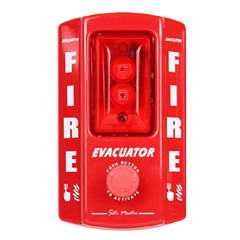
Fire Detection and Alarms
On the very smallest sites a shout of 'fire' may be adequate, on small sites a proprietary standalone unit may be adequate but as sites grow larger the requirement grows to a full fire detection and interconnected alarm system. The basic requirement is for call points and sounders, usually called site alarms; on bigger and higher risk sites where a fire may grow undetected and threaten life it may be necessary to install fire detectors linked to the alarm system. Systems may be wired in or wireless and may need to be modified as the site grows.
Hot Work Permits
Appropriate precautions must be taken when using hot work in the vicinity of flammable materials. Where possible any combustible items should be removed before the hot works commence and if this is not practicable then combustible items should be wetted. 'Hot Work Permits' should be used for all hot working processes on site and this ensures that personnel working in the restricted areas are aware of the hazards involved and the nature and extent of the work to be done. Formal checks are undertaken to confirm a safe system of work is in place before work commences and provide a record of activities. The safe system of work includes a cooling down or 'fire watch' period at the cessation of hot working activities and arrangements must be made to monitor any hot work areas during breaks.
Fire Extinguishers for Construction Sites
The type of fire extinguisher required will be determined by the risks and hazards on site:
- Water, water mist or foam for wood, paper, card etc. (Class A)
- Foam, dry water mist or dry powder (not to be used inside unless necessary) for flammable liquids. (Class B)
- CO2, dielectrically tested foams (up to 1000V) and dry water mist (up to 1000V) for electrical risks.
Further guidance on selection and positioning of fire extinguishers can be found in the BS 5306-8 Part 8. Extinguishers may be required for specific risks particularly when processes such as hot cutting are taking place but otherwise should be provided according to BS5306 part 8 2012 guidance. Multipurpose extinguishers are available and the ratings of each extinguisher should be examined.
P50 Weatherproof Fire Extinguishers can be good construction site fire extinguishers. They are service-free, meaning they do not require annual servicing from an engineer. Instead, a simple annual visual inspection can be carried out by a member of staff on site. P50 Extinguishers are also highly durable and completely weatherproof.
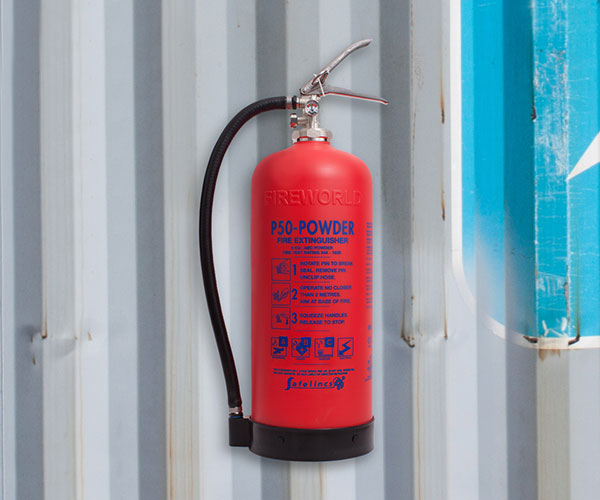
Fire extinguishers for class A materials recommends a minimum quantity of extinguishers with an A rating should be calculated as follows:
- For any storey with a floor area less than or equal to 400m2, there should be at least two extinguishers with a class A rating; having a combined minimum total fire rating of 26A.
- For any storey with a floor area exceeding 400m2, there should be at least two extinguishers with a class A rating; having a combined minimum total fire rating of 0.065 x floor area of the storey (in square metres).
- Extinguishers should be provided for other risks as appropriate.
More complex sites may require wet or dry risers to be fitted; some may need sprinkler systems.
Construction Site Fire Point
Temporary mobile site stands are an ideal solution for building sites. They can be tailored to your requirements and used as a central, accessible point to store fire safety equipment and a site fire alarm, display health and safety signage and even display your site plan. Fire safety trolleys can be made to your bespoke requirements.
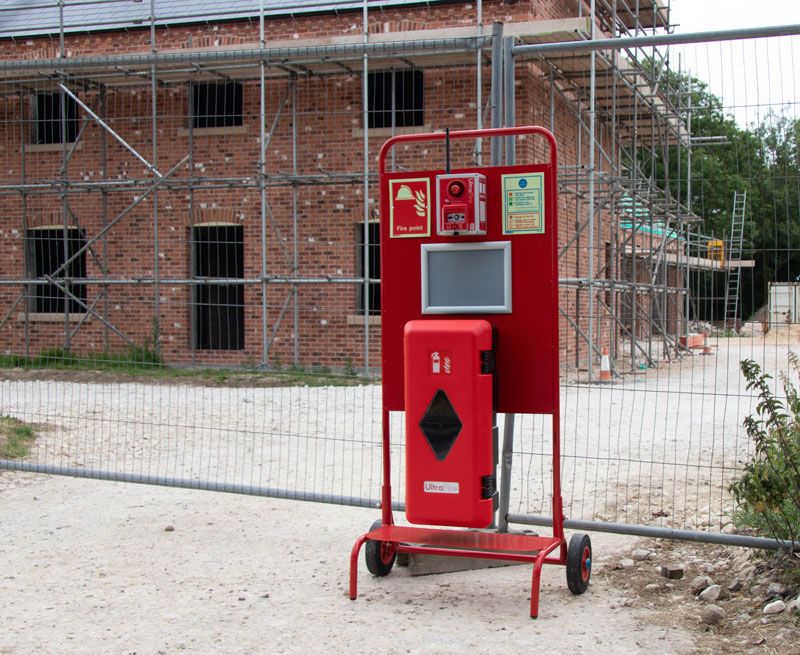
Emergency Lighting
Emergency lighting to illuminate the escape routes and for illuminating specific tasks will be required on all but the simplest sites where borrowed or spill-lighting may be adequate.
Summary
Although the CDM regulations seem complex to some the fire safety requirements are reasonably simple and don’t differ too much from regular fire safety precautions in existing buildings; the difficulty often lies in the organic nature of a building project. Effective site management is critical and preventing fires from starting and growing is key. Should you have problems with any fire safety provisions seeking professional help will often save money and time. There is a variety of options for most situations and knowing suitable alternatives is beyond those outside of the profession but good advice from manufacturers and suppliers is always available.
References and Useful Guidance/Legislation
Maintaining portable and transportable electrical equipment HSG107 Second edition
BS 7671:2018 Requirements for electrical installations - IEE Wiring Regulations
BS7375 2010 Code of Practice for the Distribution of Electricity on Construction and Demolition Sites
HSG 168 Fire safety in construction 2010
HSG 250 Guidance on permit-to-work systems: A guide for the petroleum, chemical and allied industries.
Safe handling of combustible dusts: Precautions against explosions, HSG 103
Regulatory Reform (Fire Safety) Order 2005
BS 5839: Fire detection and fire alarm systems for buildings - Part 1: Code of practice for design, installation, commissioning and maintenance of systems in non-domestic premises
BS 5266 Part 1 Code of Practice for the Emergency Escape Lighting of Premises
The Health and Safety (Safety Signs and Signals) Regulations
BS EN ISO 7010:2012 Graphical symbols - Safety colours and safety signs - Registered safety signs
BS 5306-8:2012 Fire extinguishing installations: Selection and positioning of portable fire extinguishers. Code of practice
| CDM Duty Holders | Summary of their role/main duties | |
|---|---|---|
| Clients are organisations or individuals for whom a construction project is carried out. | Domestic clients are people who have construction work carried out on their own home, or the home of a family member that is not done as part of a business, whether for profit or not. | Clients must make suitable arrangements for managing a project but for domestic clients these may be transferred to the principal contractor/contractor. Clients must ensure relevant information is prepared and provided to other duty holders and that the principal designer and contractor carry out their duties. |
| Principal designers are designers appointed by the client in projects involving more than one contractor. They can be an organisation or an individual with sufficient knowledge, experience and ability to carry out the role. | Designers are those who, as part of a business, prepare or modify designs for a building, product or system relating to construction work. | Principal designers should plan, manage, monitor and coordinate health and safety in the pre-construction phase of a project. Designers may prepare of modify designs. Both roles have a duty to eliminate, reduce or control foreseeable risks and to provide information to other members of the project team to help them fulfil their duties. |
| Principal contractors are contractors appointed by the client to coordinate the construction phase of a project where it involves more than one contractor. | Contractors are those who do the actual construction work and can be either an individual or a company. | Plan, manage, monitor and coordinate health and safety in the construction phase of a project. Contractors plan and manage work under their control so that it is carried out without risks to health and safety. The principal contractor must prepare a construction phase plan and coordinate activities in the project team. |
| Workers are the people who work for or under the control of contractors on a construction site. | Workers must take care of their own health and safety, cooperate with their employers (and others) and report anything they see which is likely to endanger either their own or others' health and safety. | |
Table 1 CDM Duty Holders
Reviewed: 28/02/2023 (doc:128 V1.2). Our articles are reviewed regularly. However, any changes made to standards or legislation following the review date will not have been considered. Please note that we provide abridged, easy-to-understand guidance. To make detailed decisions about your fire safety provisions, you might require further advice or need to consult the full standards and legislation.





















